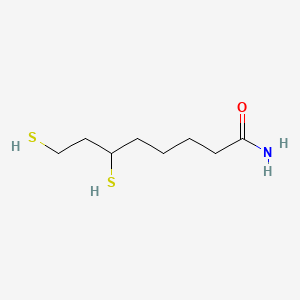| MeSH term | MeSH ID | Detail |
|---|---|---|
| Parkinsonian Disorders | D020734 | 20 associated lipids |
Dihydrolipoamide
Dihydrolipoamide is a lipid of Fatty Acyls (FA) class. Dihydrolipoamide is associated with abnormalities such as Wiskott-Aldrich Syndrome. The involved functions are known as Citric Acid Cycle, Electron Transport, NADH oxidation, Oxidation and Oxidants. Dihydrolipoamide often locates in Mitochondria, Mitochondrial matrix and Chloroplasts. The associated genes with Dihydrolipoamide are Mutant Proteins, Recombinant Proteins, mycothione reductase, Genes, Mitochondrial and alanylproline.
Cross Reference
Introduction
To understand associated biological information of Dihydrolipoamide, we collected biological information of abnormalities, associated pathways, cellular/molecular locations, biological functions, related genes/proteins, lipids and common seen animal/experimental models with organized paragraphs from literatures.
What diseases are associated with Dihydrolipoamide?
Dihydrolipoamide is suspected in and other diseases in descending order of the highest number of associated sentences.
Related references are mostly published in these journals:
| Disease | Cross reference | Weighted score | Related literature |
|---|
Possible diseases from mapped MeSH terms on references
We collected disease MeSH terms mapped to the references associated with Dihydrolipoamide
PubChem Associated disorders and diseases
What pathways are associated with Dihydrolipoamide
There are no associated biomedical information in the current reference collection.
PubChem Biomolecular Interactions and Pathways
Link to PubChem Biomolecular Interactions and PathwaysWhat cellular locations are associated with Dihydrolipoamide?
Visualization in cellular structure
Associated locations are in red color. Not associated locations are in black.
Related references are published most in these journals:
| Location | Cross reference | Weighted score | Related literatures |
|---|
What functions are associated with Dihydrolipoamide?
Related references are published most in these journals:
| Function | Cross reference | Weighted score | Related literatures |
|---|
What lipids are associated with Dihydrolipoamide?
There are no associated biomedical information in the current reference collection.
What genes are associated with Dihydrolipoamide?
Related references are published most in these journals:
| Gene | Cross reference | Weighted score | Related literatures |
|---|
What common seen animal models are associated with Dihydrolipoamide?
There are no associated biomedical information in the current reference collection.
NCBI Entrez Crosslinks
All references with Dihydrolipoamide
Download all related citations| Authors | Title | Published | Journal | PubMed Link |
|---|---|---|---|---|
| Tyler KM et al. | Limitation of Trypanosoma brucei parasitaemia results from density-dependent parasite differentiation and parasite killing by the host immune response. | 2001 | Proc. Biol. Sci. | pmid:11674871 |
| Pino P et al. | Dual targeting of antioxidant and metabolic enzymes to the mitochondrion and the apicoplast of Toxoplasma gondii. | 2007 | PLoS Pathog. | pmid:17784785 |
| Günther S et al. | Apicoplast lipoic acid protein ligase B is not essential for Plasmodium falciparum. | 2007 | PLoS Pathog. | pmid:18069893 |
| Kehr S et al. | Compartmentation of redox metabolism in malaria parasites. | 2010 | PLoS Pathog. | pmid:21203490 |
| Redanz S et al. | A five-species transcriptome array for oral mixed-biofilm studies. | 2011 | PLoS ONE | pmid:22194794 |
| Garbeva P et al. | No apparent costs for facultative antibiotic production by the soil bacterium Pseudomonas fluorescens Pf0-1. | 2011 | PLoS ONE | pmid:22110622 |
| Harvey RM et al. | A variable region within the genome of Streptococcus pneumoniae contributes to strain-strain variation in virulence. | 2011 | PLoS ONE | pmid:21573186 |
| Dozot M et al. | Functional characterization of the incomplete phosphotransferase system (PTS) of the intracellular pathogen Brucella melitensis. | 2010 | PLoS ONE | pmid:20844759 |
| Castro H et al. | Mitochondrial redox metabolism in trypanosomatids is independent of tryparedoxin activity. | 2010 | PLoS ONE | pmid:20838623 |
| Bruant G et al. | Genomic analysis of carbon monoxide utilization and butanol production by Clostridium carboxidivorans strain P7. | 2010 | PLoS ONE | pmid:20885952 |
